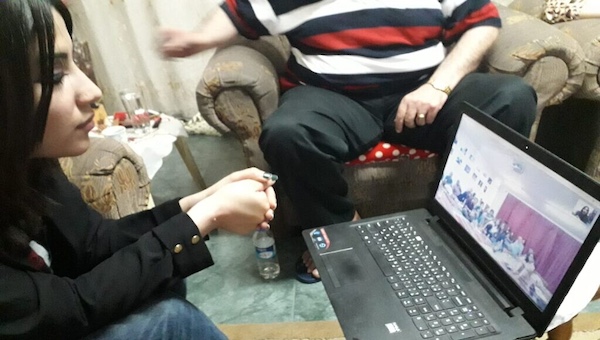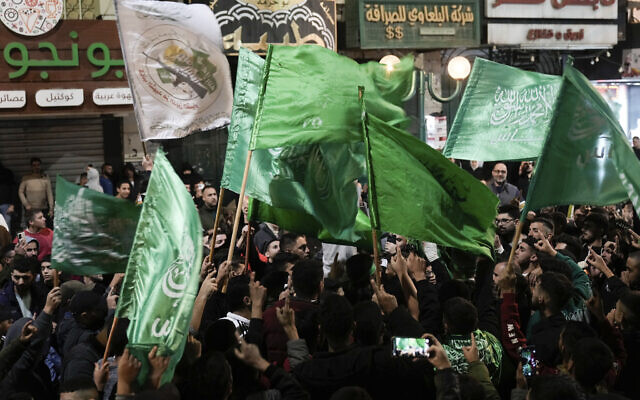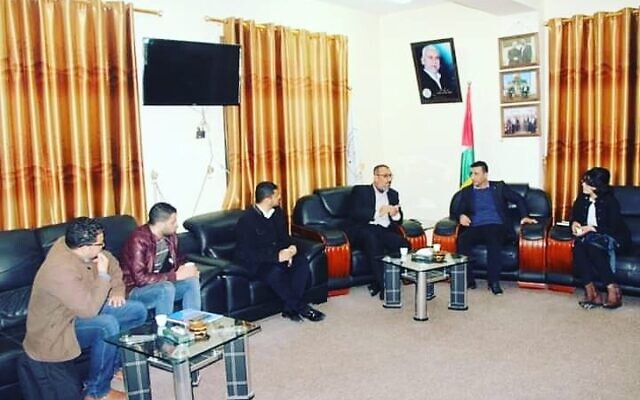
MANAR AL-SHARIF, A SYRIAN JOURNALIST, IN A VIRTUAL MEETING BETWEEN GAZANS & AMERICANS DURING RAMADAN 2019, GAZA CITY. (COURTESY)
LIFE UNDER HAMAS IS LIKE UNDER ISIS
BY: GIANLUCA PACCHIANIORIGINAL SITE: TIMES OF ISRAEL
MANAR AL-SHARIF TELLS TOI THE MAJORITY OF GAZANS DON’T BACK TERROR GROUP; SAYS OCT. 7 WAS UNSURPRISING BUT THERE’S NO VISION FOR A BETTER FUTURE IN THE FIGHTING AGAINST ISRAEL
Manar al-Sharif, a Syrian journalist, in a virtual meeting between Gazans and Americans during Ramadan 2019, Gaza City. (courtesy)
Manar al-Sharif was born in Damascus to a devout Muslim family that embraced the Palestinian cause and supported Hamas. But her views on the terror group changed dramatically after she spent three years in Gaza, including months behind bars in a Hamas jail.
Today, she is out of the Strip but still lives in a Middle Eastern country and works as a journalist. At 26, she is one of a handful of people persecuted by Hamas who managed to leave Gaza to tell their tales.
Al-Sharif’s family fled Syria for Egypt in 2013 during the Syrian civil war when she was a teenager. After completing high school in Cairo, she managed to convince her parents to allow her to pursue a degree. Her family insisted that she attend a gender-segregated Islamic university, so in 2017, she moved to Gaza City on her own and enrolled at the Islamic University to study journalism.
She dropped out of the course after only a few months, judging the curriculum “unprofessional” and permeated with Hamas propaganda, but decided to remain in the Palestinian enclave nevertheless.
When she first moved to Gaza, al-Sharif was taken aback at how pervasive Hamas’s radical Islamist ideology was. “It’s literally like ISIS – after they took over Gaza by force [in 2007], Hamas started to impose the hijab on women, and force men to change how they shave and dress,” she told The Times of Israel in an interview over Zoom.
“They have tried to make Gaza look like a totally Islamic place. You can notice it immediately. You can see everywhere on the walls posters of al-Qassam martyrs,” al-Sharif said, referring to the military wing of the terror group.
Women gesture during a rally in the Jabaliya camp for Palestinian refugees in the north of the Gaza Strip, marking the 34th anniversary of the founding of the Islamist Hamas movement which rules the Palestinian enclave, on December 10, 2021. (Mohammed ABED / AFP)
Hamas seized control of the Strip through an armed coup against the Palestinian Authority in 2007, after winning a majority of the votes in the Palestinian elections a year prior.
After Hamas took over, Israel and Egypt enforced a tight blockade on the enclave to prevent the terror group from importing weapons and materials and equipment for attacks. The blockade included severe restrictions on Gazans’ freedom of travel outside the territory, with long waiting lists to leave through the Rafah crossing into Egypt, and the Erez crossing into Israel accessible to only several thousand laborers with work permits.
“I heard from people that when Gaza was under PA control it was freer, there was alcohol, there were cinemas. But after Hamas took over, it changed radically. And the mentality of many people started to change too – not everyone, of course. But Hamas touched on a very strong point — they told Gazans to pray and to fight because they are Muslims. They played with people’s minds, and people started to be affected,” she said.
Al-Sharif, who came to Gaza as an outsider, described her first impression of Gazans’ mentality as marked by alienation, insularity and repression. “In Israel, you can complain on Facebook, you can raise your voice, you can write in English and interact with people from other countries. But most Gazans only know how to speak Arabic, and don’t have a network outside the Strip to let them know what is happening in the world.
“Gaza is a closed community. They are not used to traveling to other countries and interacting normally with outsiders. It’s literally like a jail. When you have been in jail for decades, and then you come out, you cannot have a normal conversation with those on the outside,” she said.
“People’s lives are centered around their families. There are no single people, like I was. There isn’t much to do for fun. Sometimes people go to the beach in the evenings. After being isolated from the rest of the world for so long, most people only take an interest in what happens in their immediate surroundings. They follow to a certain extent what happens in Israel — mostly to know if they can get a work permit — or in the West Bank, if they plan to move and reside there illegally.”
'Looking for change
A few months after moving to Gaza, al-Sharif started noticing changes around her. “Many women started to take their hijabs off. People started to realize that they didn’t have to follow whatever Hamas orders them, that they could be free, they could say no to Hamas. Many of them tried to travel. They were saying ‘This is not us.’ They realized that Hamas was not taking care of them, that they were doing many things wrong.”
Gazan social activists Manar al-Sharif and Rami Aman running a Skype meeting between Gazan and European schoolchildren, Gaza, 2019. (courtesy)
“During this time, some people started to meet and to organize. They were traumatized and tired.”
In 2018-2019, a spontaneous movement of young people emerged who took to the streets to demand better living conditions under the slogan “We want to live.” Dozens of protesters were arrested and beaten brutally, and al-Sharif claims some were also killed.
In her first encounter with the terror group’s repressive security apparatus, al-Sharif was beaten up by Hamas officials and jailed for two days for hosting a dinner in her apartment attended by both men and women – in violation of Hamas’s prohibition of intermingling of the sexes.
In 2018, she joined the Gaza Youth Committee, a grassroots group of young people who wanted to create change in society, including by forging connections with Israelis — for instance by holding virtual meetings that came to be known as “Skype with your enemy,” or organizing bike rides with Israelis in which people on both sides of the border rode their bikes in parallel, in a show of mutual solidarity.
Among the initiatives were peaceful marches along the border with Israel, organized in opposition to Hamas’s weekly violent border riots at the time that were known as “Marches of Return.” The peaceful protests included symbolic gestures like freeing dozens of pigeons into the sky, instead of the launching of incendiary balloons towards Israel at the Hamas-led rallies.
Gazan children participate in a peace protest on the border fence with Israel, during which they released pigeons in the air, Gaza Strip, May 4, 2018. (courtesy/ File)
“Even if you are angry, you cannot send fire balloons, because there are people on the other side. It’s not them that you are supposed to fight. Do you have a vision for your fighting?” al-Sharif wondered. “That also applies to the people in the West Bank, who go around with a knife to kill Israeli civilians. What are they doing?”
Among the initiatives launched by the Gaza Youth Committee was a public virtual meeting with people from around the world during the COVID lockdowns in April 2020, for people to compare their experiences of living under restrictions of movement. The online event attracted over 200 participants globally.
Hamas claimed that the meeting was specifically with Israelis, whereas in fact it was an open event that included people from various countries, and arrested the organizers. Most of them were sentenced to six months in prison. Al-Sharif was released on bail after spending three months behind bars, some of that time in solitary confinement.
After her release, the terror group deported her from the enclave.
“Most Gazans would much rather deal with Israel than with Hamas,” al-Sharif maintained. “There were two girls with me in jail. One had been sentenced to seven years under charges of collaborating with Israel, for allegedly sending the locations of sensitive sites. The other girl had been jailed with her husband for making art and selling it to Israelis.
“I have many friends in Gaza whose family members were killed by Hamas, either because they were affiliated with the PA, or because they were accused of collaborating with Israel. Anyone who is not with Hamas can potentially be charged. In my criminal record in the military court, it says I collaborated with Israel and foreign entities. It is not true, but they wrote trumped-up charges.”
Hamas support on the rise, but a groundswell of anger
Al-Sharif estimated that about a quarter of the Gazan population is involved with Hamas – as active operatives, public employees, or members of the security forces. The remaining 75 percent of the population, in her view, would much rather live without the terror group. “Gazans are very angry at the Hamas leadership.”
Palestinians wave Hamas flags in the West Bank city of Nablus as they celebrate the release of Palestinian security prisoners. as part of a deal between Israel and Hamas for the return of Israeli hostages, November 24, 2023. (AP Photo/ Majdi Mohammed)
Al-Sharif recounted that, during the recent seven-day truce between Hamas and Israel, as 240 Palestinian prisoners were freed by Israel in return for the release of 81 Israelis and 24 foreign nationals held hostage by Hamas, Gazans in WhatsApp groups were furious at the scenes of celebration in the West Bank. “At the same time, people were dying in Gaza. Hamas leaders care more about their prisoners [in Israeli jails] than about civilians,” she remarked.
In a screenshot provided by al-Sharif, a Gazan WhatsApp user lamented that “a true leader is one who knows how to save the blood of his people, not one who sacrifices them for foreign agendas.”
An Arab Barometer survey conducted in partnership with the Palestinian Center for Policy and Survey Research and concluded on October 6, one day before the Hamas attack on Israel, found that only 29% of Gazans expressed either “a great deal” or “quite a lot” of trust in the Hamas government, while 44% said they had “no trust at all,” and 23% said “not a lot.” Only 24% of respondents said they would vote for Hamas leader Ismail Haniyeh in hypothetical presidential elections.
A recent poll found that three in four Palestinians — polled in Gaza and the West Bank — support Hamas following the October attacks. Meanwhile, Ramallah-based pollster Khalil Shikaki claimed in a recent interview that support for Hamas in the West Bank has probably tripled following the release of the Palestinian prisoners during the truce.
“People in the West Bank are very naive. They know nothing about life under Hamas; they know nothing about the Gazans,” al-Sharif remarked.
Gazan activists from the Gaza Youth Committee movement, among them journalist Manar al-Sharif (first on the right), meet with members of Hamas’ Ministry of the Interior to discuss the release of members of the youth group arrested by Hamas, April 1, 2019. (courtesy)
Commenting on Israel’s stated goal of destroying Hamas, al-Sharif said: “I wish Israel good luck. But I don’t think they will manage. The US tried for 20 years to take the Taliban out of Afghanistan, and eventually the Taliban returned to power.”
“I understand where Israelis are coming from. They were shocked by the October 7 onslaught – but as someone who used to live in Gaza, I was not surprised that it happened. Eradicating Hamas is going to be difficult, and will involve many steps.”
“Israel would need to move a lot of people out of Gaza – and Egypt should open their borders. But even after an evacuation of civilians, Hamas knows every corner in Gaza – even if the IDF has maps, it doesn’t know where Hamas is hiding.”
Speculating about possible scenarios for the coastal enclave after the war, al-Sharif hoped to see a territory with open borders, and economic cooperation with Israel, such as through the creation of an industrial zone for Gazan workers, which could also be in Israel’s interest (Israeli leaders, meanwhile, have indicated they aim to cut off ties with Gaza completely, including no longer allowing laborers in).
For the time being, she admitted that this is only wishful thinking. “No one has come forward with a clear plan for what to do with Gaza. There is no vision. It’s so disappointing.”
AWFSM CATEGORIES
Activism | AI | Belief | Big Pharma | Conspiracy | Cult | Culture | Deep State | Economy | Education | Entertainment | Environment | Faith | Global | Government | Health | Hi Tech | Leadership | Politics | Prophecy | Science | Security | Social Climate | Universe | War






